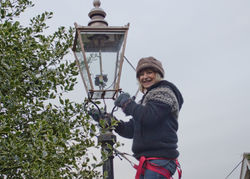The Malvern Gaslamps
Malvern’s gaslamps are an important part of the town’s Victorian heritage. There are 104 dotted around the area, yet amazingly, until very recently there were suggestions they should all be removed.
‘In 1905, Malvern had 1,250 gas lamps’ says Brian Harper from The Transition Gasketeers, a group set up by Transition Malvern Hills to restore, maintain and improve the town’s remaining lanterns. ‘The authorities began removing them in the 1950s , continuing through the sixties until there were only 120 or 130 lamps left. Every few years, councillors would debate whether they should remove the remainder. Finally, in 1999, they were listed and so now their future is protected.’
At the dawn of the new millennium, the tide turned and a number of new lamps were installed on Belle Vue Terrace and in Rosebank Gardens. Then in 2010 the Transition Gasketeers came together when local councils needed to find a financially viable way to keep the lamps functioning. ‘At no charge we researched ways they could be rescued and improved’ says Brian, ‘then demonstrated what could be done. The councils asked the Gasketeers to tender for the work via my company Sight Designs, something we hadn’t planned to do, but with some reluctance we took up the challenge as a part-volunteer project.’
A map pinned to the wall of Brian’s laboratory shows the scale of the task. The lamps are dotted right around the Hills, and although Great Malvern town centre has many Town and District Council lanterns, there are many others in Malvern Wells and West Malvern. ‘When we began, many were in an atrocious state - particularly those in Malvern Wells’ says Brian. ‘The town has lanterns that represent several stages of the development of gas light from Victorian times until the 1950s. There are ten different versions of lantern from five different manufacturers! Obviously replacement parts can no longer be bought, so we had to carefully refurbish and frequently manufacture our own parts.’
The Gasketeers improved on the original designs which resulted in a brighter light range and reduced maintenance costs of up to 80 percent while reducing the consumption of gas by 70 percent. ‘We have brought down the cost of running the lamps to only a little more than conventional sodium street lamps. Their carbon footprint has been dramatically reduced’ says Brian. ‘Funded primarily by the District Council on a ‘spend to save’ ticket the savings are recovering the cost in only three years.’
‘Sometimes when we’re out working on a lamp, people appear at the foot of the ladder and personally thank us for what we do’ says Brian. ‘It’s remarkable how many are visitors to the town who are genuinely surprised and delighted that we still have gas lighting.’
Refurbishing and maintaining 104 gas lamps has been a huge undertaking. ‘Few people realise how much work has happened in the background to rescue the lanterns’ says Brian. ‘We’re bringing gaslight into the 21st Century, taking something that dates back to 1760 and updating it with our own technology. We have now developed an identical electrically powered gas lamp that can easily extend gaslight in Malvern.’
The group is busy installing these new technology gas lanterns outside Great Malvern and Malvern Link stations for the Town and County Councils. ‘Arguably Malvern has the most advanced gas lighting in the world’ says Brian. ‘We are providing local employment, but also there is much Transition volunteer effort to thank for keeping Malvern’s gas lamps alight.’





